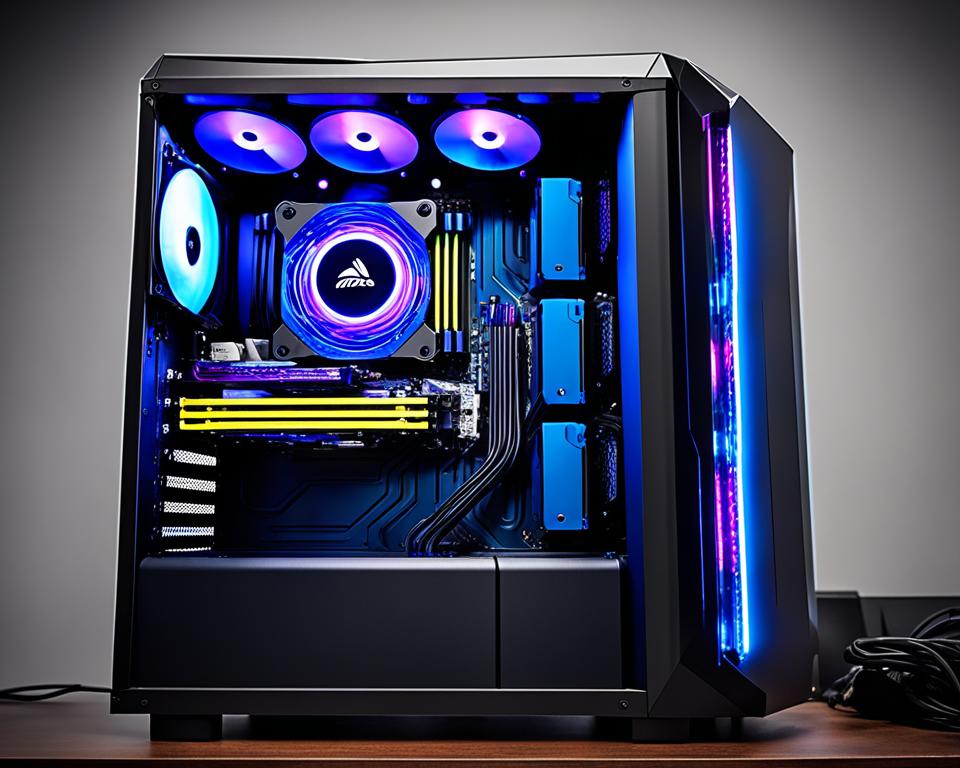Are you looking to upgrade your gaming setup or workstation? If so, you may have heard about the benefits of a vertical mount GPU. This sleek and efficient piece of technology has been gaining popularity among tech enthusiasts.
Let me tell you a story.
Picture this: You’re sitting at your desk, engrossed in an intense gaming session. The graphics are stunning, and you’re completely immersed in the virtual world. But suddenly, you start to feel a warm breeze on your face. You look down and realize that your computer case is emitting an alarming amount of heat. The excitement quickly turns to worry as you realize that your GPU might be overheating.
This was the exact situation Alex found himself in. His trusty gaming PC had served him well for years, but as technology advanced and games became more demanding, he noticed a decline in performance and increased temperatures. Alex knew he needed a solution and began researching ways to improve airflow and cooling in his system.
That’s when he stumbled upon the concept of vertical mounting a GPU. He learned that by positioning the graphics card vertically inside the computer case, he could create a more efficient airflow pathway. This would not only keep the GPU cooler but also enhance the overall performance of his gaming rig.
Intrigued by the possibilities, Alex embarked on a mission to install a vertical mount GPU in his computer. He followed step-by-step instructions, carefully removing his old GPU and securing the new one in a vertical position. The process was straightforward, and after completing the installation, Alex could already feel the difference in his computer’s temperature.
As he fired up his favorite game, he was amazed at how smooth and fluid the gameplay was. The graphics were pristine, and the cooling system was doing its job flawlessly. Not only did his computer look sleek and modern with the vertical mount GPU, but the performance boost was undeniable.
From that day forward, Alex became a firm believer in the benefits of vertical mount GPUs. He loved how it improved both the cooling and aesthetic aspects of his gaming setup. It was a win-win situation, and he couldn’t be happier with his decision.
Now, it’s your turn to elevate your computer’s performance and aesthetics to new heights. Let’s explore the advantages of vertical mount GPUs and learn how to install one in your own computer!
Key Takeaways:
- Vertical mount GPUs offer improved airflow and cooling, resulting in lower temperatures and enhanced performance
- Installing a vertical mount GPU can give your computer a sleek and modern look, enhancing the overall aesthetics of your setup
- Proper installation is crucial to ensure compatibility with your computer case and to avoid any interference or airflow issues
- Regular maintenance and troubleshooting will help optimize the performance and longevity of your vertical mount GPU
- Consider the top brands and models on the market when choosing a vertical mount GPU, taking into account compatibility, cooling capabilities, and design aesthetics
What is a Vertical Mount GPU and How Does it Work?
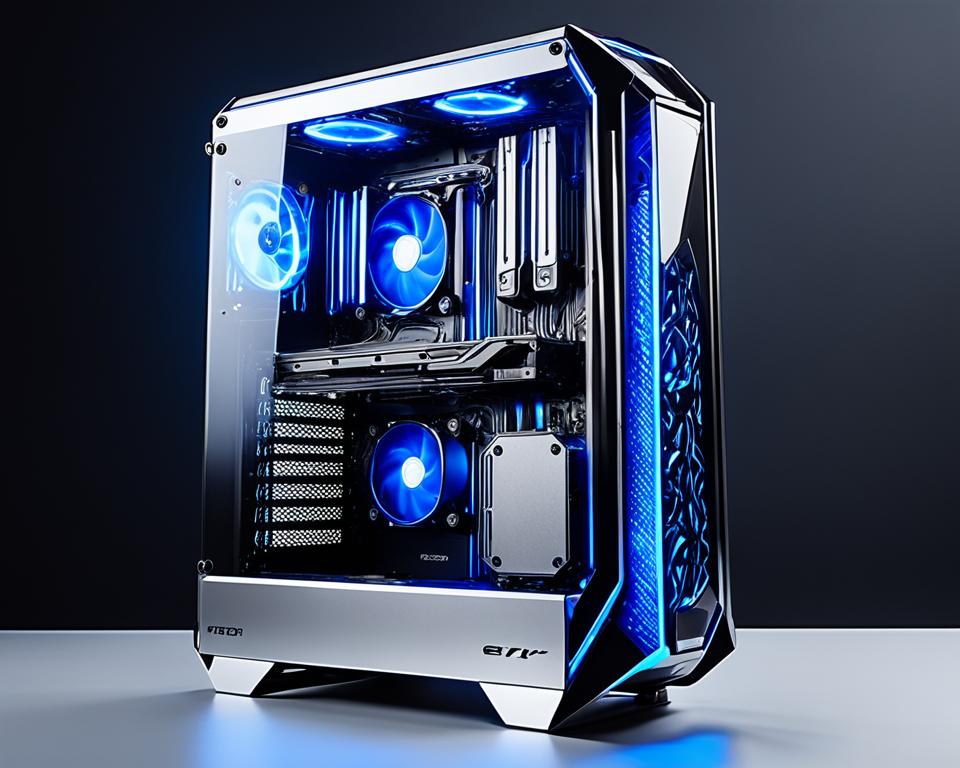
A vertical mount GPU, also known as a vertical GPU mount, is a graphics card that is positioned vertically inside the computer case. Unlike the traditional horizontal placement, which is the standard method of mounting a GPU, a vertical mount GPU allows for a more efficient cooling system and improved airflow within the case.
By mounting the GPU vertically, it allows for better utilization of space and creates a clear path for air to flow through the graphics card. This results in lower temperatures and improved performance, as the GPU can operate at optimal levels without overheating.
Furthermore, a vertical mount GPU offers the added benefit of showcasing the graphics card’s design and lighting effects. When the GPU is mounted vertically, the side panel of the case allows for a clear view of the card, enhancing the overall aesthetics of the computer setup.
To achieve a vertical mount setup, most modern computer cases are equipped with brackets or PCIe riser cables. These components allow you to connect the GPU to the motherboard at a perpendicular angle, ensuring a secure and stable connection. While the setup process may seem daunting at first, it is relatively straightforward for anyone familiar with building a PC.
“A vertical mount GPU provides improved cooling, better airflow, and a visually appealing display of the graphics card’s design.”
With a vertical mount GPU, you can optimize your computer’s performance, prevent overheating, and elevate the aesthetics of your gaming or workstation setup. In the next section, we will explore the advantages of a vertical mount GPU for gaming and graphics design.
The Advantages of a Vertical Mount GPU for Gaming and Graphics Design
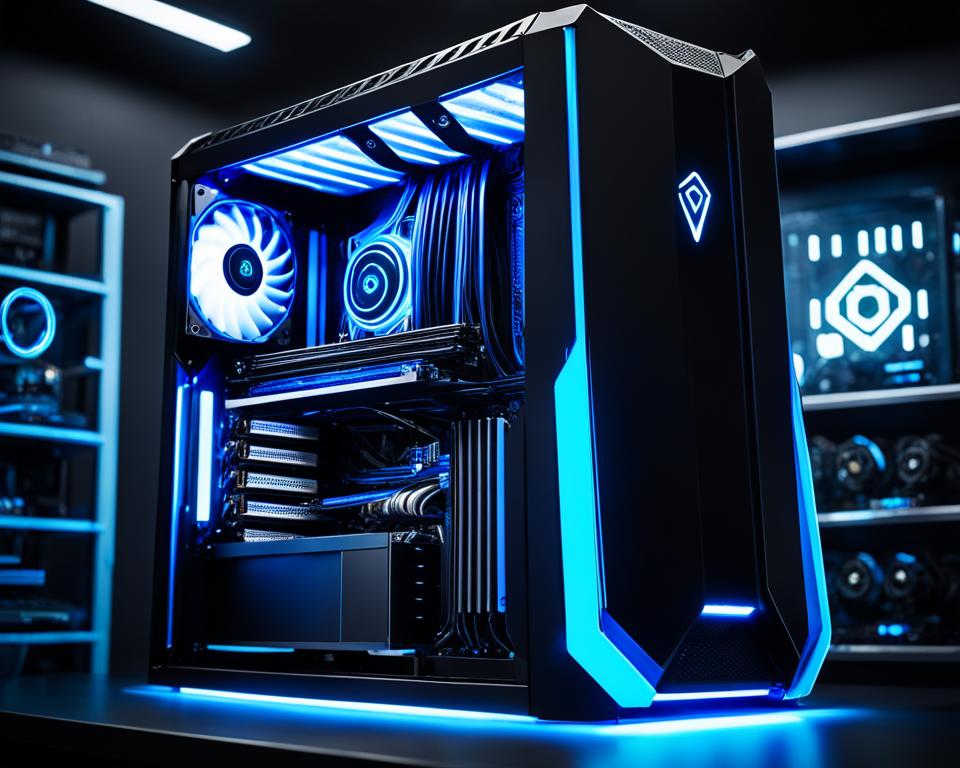
A vertical mount GPU offers several benefits for gamers and graphics designers. By positioning the graphics card vertically inside the computer case, it provides better airflow, resulting in lower temperatures and improved performance. This enhanced cooling can contribute to longer gaming sessions and more efficient rendering for graphics-intensive tasks.
In addition to its cooling capabilities, a vertical mount GPU also adds a touch of modernity and sleekness to your computer setup. With the graphics card displayed vertically through the side panel of the case, you can showcase its design and any RGB lighting effects, elevating the aesthetic appeal of your gaming rig or workstation.
Moreover, a vertical mount GPU simplifies cable management and improves connectivity. The vertical position allows for easier access to the ports on the graphics card, ensuring a smoother installation process and reducing the hassle of plugging and unplugging cables. This feature is particularly beneficial for graphics designers who frequently connect and disconnect various peripherals.
It’s important to note that not all computer cases are compatible with vertical mounting. Before purchasing a vertical mount GPU, ensure that your case has the necessary brackets or PCIe riser cables to support this configuration. Checking compatibility beforehand will save you the frustration of discovering that your chosen GPU cannot be vertically installed in your case.
Let’s summarize the advantages of a vertical mount GPU:
- Better airflow and improved cooling
- Sleek and modern aesthetic
- Easier cable management and connectivity
Take a look at the following table comparing the benefits of a vertical mount GPU to a traditional horizontal mount:
| Advantages | Vertical Mount GPU | Traditional Horizontal Mount |
|---|---|---|
| Better airflow and cooling | ✓ | ✓ |
| Sleek and modern aesthetic | ✓ | – |
| Easier cable management and connectivity | ✓ | – |
As you can see, a vertical mount GPU offers unique advantages in terms of cooling, aesthetics, and convenience. However, the choice between vertical and horizontal mounting ultimately depends on your preferences and the compatibility of your computer case. Consider these factors when deciding how to configure your GPU to optimize your gaming or graphics design experience.
How to Install a Vertical Mount GPU in Your Computer
Upgrading your computer with a vertical mount GPU can enhance both its performance and aesthetics. To install a vertical mount GPU in your system, follow these simple steps:
Step 1: Ensure Compatibility and Clearance
Before starting the installation process, make sure that your computer case is compatible with vertical GPU installation. Check for any size restrictions or obstructions that might hinder the installation process. It is also crucial to ensure that you have enough clearance for the GPU to fit properly.
Step 2: Remove Existing Graphics Card
Begin by removing any existing graphics card from the PCIe slot where the new GPU will be installed. Carefully unscrew any screws that are securing the graphics card in place.
Step 3: Attach the PCIe Riser Cable
The PCIe riser cable is a vital component that allows you to connect the GPU to the motherboard at a perpendicular angle. Attach one end of the riser cable to the motherboard’s PCIe slot, and the other end to the vertical bracket included with the case.
Step 4: Slide in the GPU
Slide the GPU onto the vertical bracket, aligning it with the PCIe slot on the motherboard. Ensure that the GPU is securely positioned on the bracket.
Step 5: Secure the GPU
To ensure the GPU remains in place, use the screws provided to secure it onto the vertical bracket. Take care not to overtighten the screws to avoid damage to the GPU or bracket.
Step 6: Connect Power Cables
Finally, connect the necessary power cables to the GPU, ensuring a secure and proper connection. Refer to the GPU’s user manual for guidance on the specific power requirements and cable connections.
It is essential to check for any potential interference or airflow issues during installation and monitor temperatures during use. If you encounter any difficulties, referring to the manufacturer’s instructions or seeking professional assistance is recommended.
| Tips for Installing a Vertical Mount GPU | |
|---|---|
| Tip 1: | Double-check your computer case’s compatibility and clearance for vertical GPU installation before purchasing a vertical mount GPU. |
| Tip 2: | Be gentle and careful when removing the existing graphics card to avoid any damage to the motherboard or other components. |
| Tip 3: | Read the GPU and case manufacturer’s instructions carefully to ensure proper installation and avoid any potential issues. |
| Tip 4: | Monitor temperatures after installation to ensure proper cooling and prevent overheating. |
| Tip 5: | If you’re unsure about any aspect of the installation process, it’s best to seek help from a professional or consult with customer support. |
By following these steps and tips, you’ll be able to install a vertical mount GPU in your computer and experience the benefits of improved performance and sleek aesthetics.
Vertical Mount GPU vs Traditional Horizontal Mount: Which is Better?
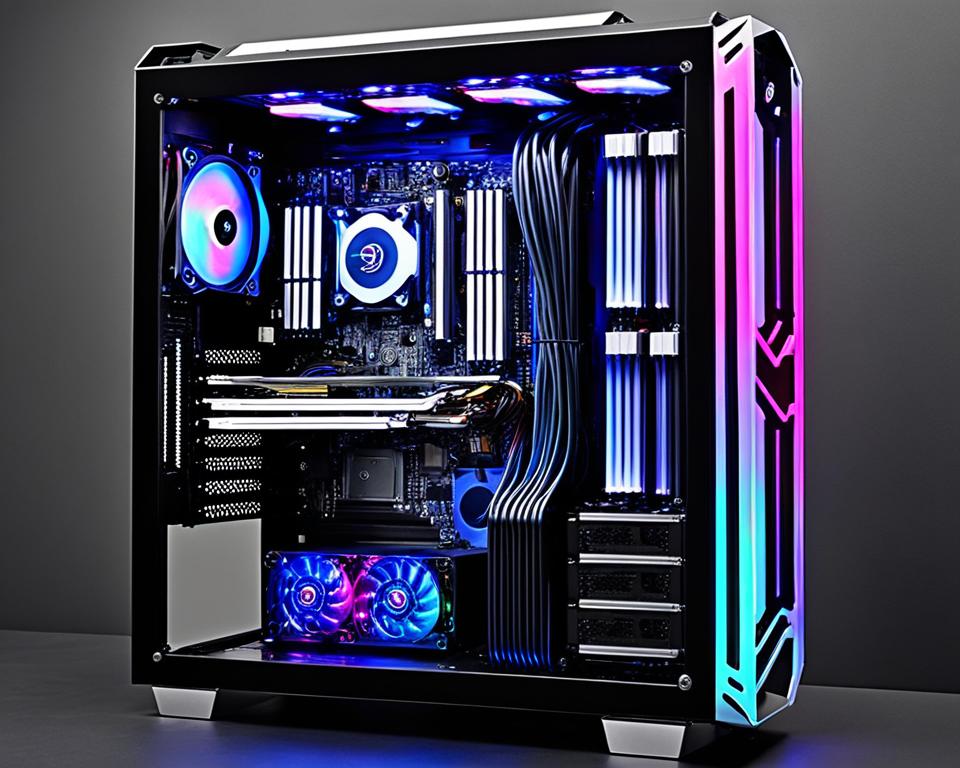
The choice between a vertical mount GPU and a traditional horizontal mount depends on individual preferences and specific needs. A vertical mount GPU offers improved airflow and aesthetics, making it ideal for showcasing the graphics card’s design. However, not all computer cases support vertical mounting, so compatibility should be considered. Traditional horizontal mounting is the standard method and often provides better airflow to other components. It is important to weigh the pros and cons and choose the option that best suits your requirements.
When it comes to vertical GPU case compatibility, it’s crucial to ensure that your computer case supports a vertical mount setup. Some cases have built-in brackets or riser cables that make vertical mounting a breeze, while others may require additional modifications or accessories. Before deciding to go with a vertical mount GPU, check the specifications and compatibility of your case to avoid any compatibility issues.
Although vertical GPU setup has its advantages, traditional horizontal GPU mounting still remains a reliable and widely-used method. Horizontal mounting provides better cooling for other components, such as the CPU and RAM, as the airflow is not concentrated solely on the GPU. This can be especially beneficial for systems that require intensive tasks, such as gaming or graphics design.
Ultimately, the decision between vertical and horizontal GPU mounting depends on your personal preferences, case compatibility, and airflow requirements. Consider the layout of your case, the cooling needs of your components, and the visual appeal you desire for your setup. Take a look at the table below for a quick comparison of the two mounting options:
| Vertical Mount GPU | Traditional Horizontal Mount | |
|---|---|---|
| Aesthetics | Showcases graphics card design | Standard method |
| Airflow | Improved airflow for GPU | Better airflow for other components |
| Compatibility | Dependent on case support | Compatible with most cases |
As you can see, both mounting options have their own strengths. It’s important to carefully consider your specific needs and the capabilities of your computer case before making a decision.
Image: A visual representation of a vertical GPU setup, showcasing the graphics card in a vertical position. (Alt text: Vertical GPU Setup)
The Top Brands and Models of Vertical Mount GPUs on the Market
When it comes to choosing the best vertical GPU mount, there are several top brands and models that stand out in the market. These brands offer exceptional performance, cooling capabilities, and design aesthetics. Whether you’re a gamer or a graphics designer, selecting the right vertical GPU mount can make a significant difference in your computing experience.
Here are some of the top brands and models to consider:
1. Thermaltake Core P5: This vertical GPU mount features a clear acrylic panel that allows for easy viewing and showcases the graphics card’s design. It offers excellent cooling capabilities, ensuring optimal performance even during intense gaming sessions.
2. Cooler Master MasterCase H500M: Known for its exceptional cooling capabilities, this vertical GPU mount is perfect for those who prioritize keeping their components cool. It also offers ample space for cable management, ensuring a clean and organized setup.
3. Phanteks Eclipse P400A: If you’re on a budget, this vertical GPU mount is a great option. It features a spacious interior that can accommodate various GPU sizes and provides good cable management options, resulting in a neat and tidy build.
4. Lian Li PC-O11 Dynamic: Another budget-friendly option, this vertical GPU mount offers a spacious interior to accommodate different components. It provides ample room for cable management, allowing for a clean and clutter-free setup.
Other notable brands in the vertical GPU mount market include ASUS, Corsair, and NZXT, which offer a wide range of options to suit different needs and preferences.
When selecting a vertical GPU mount, it’s important to consider factors such as compatibility with your case, cooling capabilities, and overall design aesthetics. Choose a brand and model that aligns with your requirements and enhances your gaming or graphics design experience.
Comparison Table: Top Brands and Models of Vertical Mount GPUs
| Brand | Model | Key Features |
|---|---|---|
| Thermaltake | Core P5 | Clear acrylic panel, excellent cooling |
| Cooler Master | MasterCase H500M | Exceptional cooling, good cable management |
| Phanteks | Eclipse P400A | Budget-friendly, spacious interior, good cable management |
| Lian Li | PC-O11 Dynamic | Budget-friendly, spacious interior, clean cable management |
| ASUS | Various models | Wide range of options available |
| Corsair | Various models | Diverse selection with different features |
| NZXT | Various models | Offering versatility and performance |
As you can see, there is a wide selection of top brands and models available in the vertical GPU mount market. Consider your specific requirements and preferences, and choose a vertical GPU mount that will enhance your computer’s performance, cooling, and overall aesthetics.
Tips for Maintaining and Troubleshooting Your Vertical Mount GPU
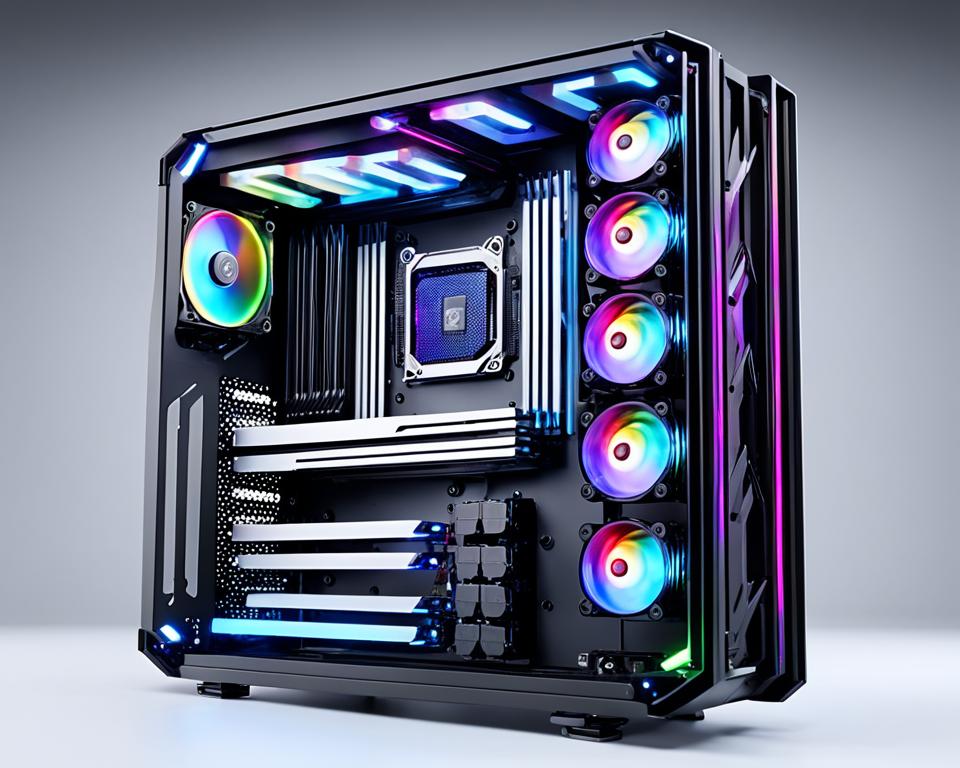
Maintaining and troubleshooting your vertical mount GPU is crucial for optimal performance and longevity. By following these tips and guidelines, you can ensure that your GPU continues to work efficiently and provide the best gaming or graphics design experience.
- Clean your GPU regularly: Dust buildup on the fan blades and heatsink can hinder airflow and lead to overheating. To prevent this, use compressed air or a soft-bristled brush to gently clean these components. Regular cleaning will help maintain proper cooling and prevent performance issues.
- Monitor your GPU temperature: Install software applications like MSI Afterburner or EVGA Precision XOC to monitor the temperature of your GPU. Keeping an eye on the temperature levels will allow you to detect any potential overheating problems and take immediate action if necessary.
- Check for loose connections: If you encounter any issues with your vertical mount GPU, such as artifacts on the display or crashes, it’s important to check for loose connections. Make sure that the cables connecting your GPU to the motherboard and power supply are securely attached and not damaged. Loose connections can cause intermittent issues and impact performance.
- Update your graphics card drivers: Graphics card drivers play a crucial role in ensuring optimal performance and compatibility with the latest games and software. Regularly check for driver updates on the manufacturer’s website and install them to take advantage of bug fixes and performance optimizations.
- Adjust clock speeds and power limits: For advanced users, tweaking the clock speeds and power limits of your GPU can optimize performance. However, it’s essential to do this cautiously and make small adjustments to avoid instability or overheating. Consult online resources or manufacturer documentation for guidance on safely adjusting these settings.
- Contact technical support if needed: If you encounter persistent issues or problems that you cannot resolve on your own, reach out to the technical support team of your GPU’s manufacturer or the retailer from whom you purchased it. They can provide you with specific troubleshooting steps or arrange for repairs or replacements if necessary.
Proper maintenance and proactive troubleshooting can help prevent costly repairs and ensure that your vertical mount GPU delivers optimal performance throughout its lifespan.
“Maintaining and troubleshooting your vertical mount GPU is crucial for optimal performance and longevity.”
Why Upgrading to a Vertical Mount GPU is Worth the Investment
Upgrading to a vertical mount GPU is a worthwhile investment for gamers and graphics designers. This upgrade not only enhances the overall performance and cooling of your computer but also adds a touch of aesthetics to your setup. By opting for a vertical mount GPU, you can unlock a range of benefits that will elevate your gaming and graphics design experience.
Improved Performance
With a vertical mount GPU, you can enjoy faster load times and smoother gameplay. The vertical position allows for better air circulation, preventing excessive heat buildup and ensuring optimal performance even during intense gaming sessions. Whether you’re playing the latest AAA titles or rendering high-resolution graphics, a vertical mount GPU will deliver the power and efficiency you need.
Elevated Cooling Efficiency
A vertical mount GPU optimizes cooling by allowing better airflow within your computer case. The vertical positioning exposes the graphics card to fresh air, reducing heat trapped inside the case. This efficient cooling not only improves the longevity of your GPU but also minimizes the risk of overheating, ensuring stable performance even under demanding workloads.
Sleek Design and Cable Management
The sleek design of a vertical mount GPU adds a touch of sophistication to your computer setup. It transforms your graphics card into a centerpiece, showcasing its design and lighting effects through the side panel of your case. Additionally, the vertical orientation simplifies cable management, allowing for cleaner and more organized setups.
“A vertical mount GPU not only enhances the performance and cooling of your computer but also adds a touch of elegance to your gaming or graphics design experience.”
Long-Term Investment
While the initial cost of a vertical mount GPU may be slightly higher than a traditional horizontal mount GPU, the long-term benefits make it a worthwhile investment. The improved performance, efficient cooling, and sleek design will enhance your computing experience for years to come. By upgrading to a vertical mount GPU, you future-proof your system and ensure compatibility with the latest technologies and advancements in graphics processing.
So, if you’re looking to elevate your gaming and graphics design experience, upgrading to a vertical mount GPU is definitely a smart investment. Experience faster performance, efficient cooling, and a visually stunning setup that will take your computer to new heights.
Conclusion
Vertical mounting a GPU offers a myriad of benefits, making it a popular choice among gamers and graphics designers. With improved cooling, better aesthetics, and easier access to ports, it enhances both performance and visual appeal. By optimizing airflow within the computer case, vertical mounting ensures lower temperatures and optimal GPU performance. While not all cases are compatible, there are options available that allow for vertical GPU mounting.
When considering a vertical mount GPU, it’s important to weigh the pros and cons and choose from the top brands and models available on the market. Brands like Thermaltake, Cooler Master, Phanteks, and Lian Li offer reliable and feature-rich options. Proper maintenance and troubleshooting are vital to ensure optimal performance and longevity of the vertical mount GPU. Regular cleaning, temperature monitoring, and software updates help maintain peak performance.
Upgrading to a vertical mount GPU is a worthy investment for those looking to enhance their gaming and design experience. The combination of improved cooling, aesthetics, and performance optimization results in faster load times, smoother gameplay, and efficient rendering. While the initial cost may be higher, the long-term benefits make it a worthwhile upgrade. So, if you’re looking to take your computer setup to the next level, consider vertical mounting your GPU and elevate both your gaming and design experience.

